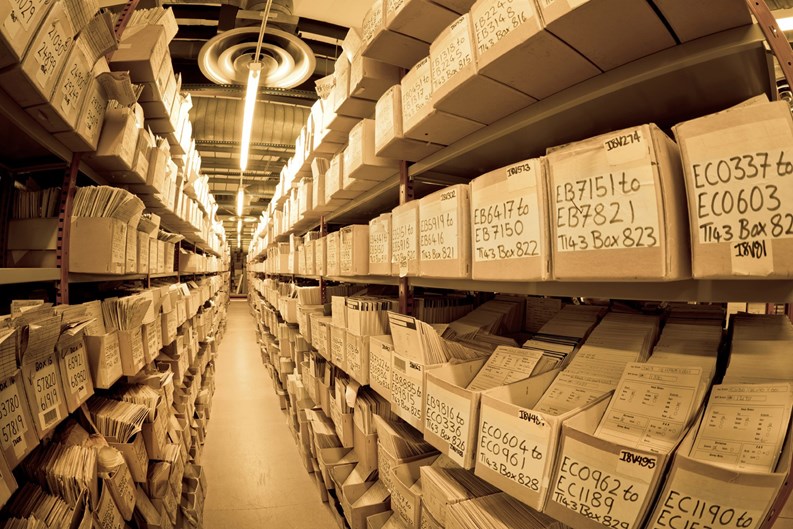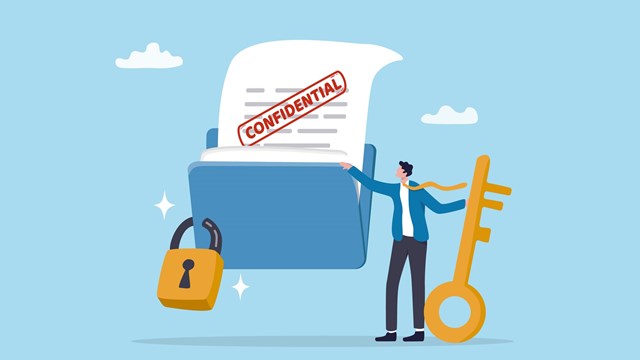Like any company, a multifamily residential community generates a lot of paperwork in the course of doing business, from employment records to tenant records and more. It can be an enormous amount of stuff to manage, and knowing what to keep—as well as what can be tossed —isn’t always obvious. In operating a multifamily community, though, it’s important to know what records must be discarded or kept, and for how long. Best practices and some laws dictate treatment of certain documents, and a building’s management-board team should at least be familiar with what goes where.
Filing Paperwork
Understanding the difference between documents that should be destroyed immediately after their use at a board meeting, for example, and those that should be secured and saved for years to come is the responsibility of both the board and the property manager. Of course such decisions can be made with the help of their attorney, but all of these parties have a fiduciary responsibility to run the community as a business, which includes keeping records as long as needed. Keeping those records or disposing of them can not only keep administrators and community alike on the right side of the law, it can also help shield a building or association from some kinds of litigation.
Some of the documents generated in the course of running a condo, co-op building or HOA include attorney correspondence, vendor contracts, blueprints, maintenance schematics and other equipment or operations and maintenance (O&M) manuals, floor plans, and more. A building’s governing documents, meeting minutes, tax information, and proofs of inspections often are also retained, says Patti Harris, special counsel for Zetlin & De Chiara LLP, a New York City law firm, that also has offices in New Jersey and Stamford, Connecticut.
Some records that should be kept include leasing documents, emergency evacuation plans, shut-off valve maps, and a schematic of the building’s fire suppression system, says David Trask, business development representative for ARC Document Solutions, a document management and cloud-based hosting company headquartered in Walnut Creek, California, with more than 150 offices across the country, including Massachusetts, Connecticut and Rhode Island. “Oftentimes this stuff is in the construction documents and could also be in the tenant improvement documents,” Trask says.
Other building documents that should be kept by management include water testing reports, asbestos reports, environmental plans, and warranties on equipment, Trask says. “All of that documentation has to live somewhere—often it’s on paper, in a storage room and not safe; though it would be safer in cloud storage,” he says.
Retaining building documents for the requisite period is more than a legal requirement; it’s also just good business. It covers the building’s bases, so to speak. “There can be federal, state or city laws on how long the record must be kept,” Harris says. “Typically, tax records are kept for seven years, since the statute says they must be kept for six years.” Check with your municipality or jurisdiction about how long records should be maintained.
But what about records that may not be mandated by law, which best practices suggest should be kept by management for a time? One unwritten rule of thumb pertains to the record’s ability to affect litigation. The board and manager always want to consider the statute of limitations on litigation that could pertain to each of the documents, Harris says.
Other experts say that managing such records is simplified if they are organized in part based upon how long they will be retained.
“Some of the most common documents and paperwork generated in co-ops and condos are owner financial statements, payment receipts, inspection reports, violation reports, condo association charter/governing documents, covenants, conditions and restrictions, bylaws, articles of incorporation, the operating budget, and insurance policies,” says Sam Driver, director of product management for Buildium, a property management software firm based in Boston. “Think about these documents as fixed or rarely changing, like articles of incorporation; or, dynamic, like groupings of monthly expenses or budget forecasts over time.”
And in Massachusetts, certain records requirements must be met. For example, Massachusetts General Laws, Chapter 183A, Section 10 lists documents that the (condominium) association must make available and sets forth the procedure for obtaining them, according to attorney Henry Goodman, a principal and co-founder at the Dedham, Massachusetts-based law firm of Goodman, Shapiro & Lombardi, LLC.
Per the Massachusetts Condo Act, says Goodman, the association must keep copies of the following records for at least seven years: “a true and accurate copy of the master deed as recorded and amended; the bylaws, including amendments thereto, as recorded; the minute book, as maintained by the organization of unit owners, to the extent such minutes are kept; and financial records, including the following: records of all receipts and expenditures, invoices and vouchers authorizing payments, receivables, and bank statements relating thereto.” Also to be kept, he says, are any “records regarding the replacement reserve fund or any other funds of the organization of unit owners and bank statements; audits, reviews, accounting statements, and financial reports relating to the finances of the organization of unit owners; contracts for work to be performed for or services to be provided to the organization of unit owners; and all current insurance policies of the organization of unit owners, or policies which name the organization as an insured or obligee.”
Connecticut, under its Common Interest Ownership Act (CIOA) also has provisions for recordkeeping. Condominiums are required to retain under Sect. 47-260 of the General Statutes, detailed records of receipts and expenditures affecting the operation and administration, all appropriate accounting records; minutes of all meeting of the unit owners or executive board; names of all unit owners; the association’s original or restated organizational documents, if required by law, including bylaws, and all amendments to bylaws, and all rules currently in effect; all financial statements and tax returns of the association for the past three years; names and addresses of the current board or association; most recent annual report registered with the Secretary of the State; copies of contracts to which the association is a party; records of executive board or committee actions approving or denying requests for design or architectural approval from unit owners; and ballots/proxies and other records for one year after elections. The statute also notes that the records shall be retained by the association and be available for inspection or copying by a unit owner or owner’s authorized agent during reasonable business hours at a mutually convenient time and location upon five days’ notice of the request.
Vermont’s Uniform Common Interest Ownership Act of 1994 lists similar requirements for inspection and request for access notice times. While Maine’s Condominium Act requires a 10-day written notice, it states that associations reserve the right to charge “a reasonable fee for providing copies.” The Rhode Island and Vermont statutes are relatively vague, essentially stating that owners are entitled to review records, but providing no specifics on notification requirements or fees.
Where to Put It?
In today’s world, where no matter where you live things like terrorist attacks and other man-made disasters are not unheard of, residents must be prepared for every emergency. Part of that preparation means having an evacuation plan and a shelter-in-place plan in case flooding or another disaster dictates that residents leave—or stay in their apartments—for days. For a building’s management, preparing for the worst also means having immediate access to all the information available on the building that could be helpful.
Given such necessities, where should important records and documents be physically stored in a residential building? And where should they not be kept? Industry pros say these records should not be kept in the building itself but off-site or as cloud-based storage.
“You’re best off storing any records you have related to a condo association—from financial statements to maintenance records to inspection reports—in the cloud,” says Driver. “There’s no limit to how much you can store, and you can do so without taking up any physical space.”
Some might wonder if electronic storage is safe for storing crucial documents and potentially sensitive personal information. Most experts agree that if stored in the cloud, it’s probably safer than storing paper copies, which can be ruined by fire or flooding, or compromised by prying eyes.
“One best practice is to file all documents and communication electronically—where you can find and share them more easily, where they don’t clutter your office, and where they’re safer than they are in physical form,” Driver says. “Electronic storage in the cloud is much safer than filing in cabinets or on a personal computer.”
Data kept on a single PC could be irretrievable if that computer is damaged. But cloud storage means that the information stored is backed up by multiple servers that may be scattered around the world. Even if one goes down, there are always backups to protect the data stored on them. The same cannot be said of a single piece of paper locked in a metal filing cabinet or in a box on a storage unit shelf.
Getting Help
Many residential buildings in larger, older cities have been around for a while, and records for them could have gaps. While nobody is perfect and a few holes in the recordkeeping here and there are not cause for great alarm, buildings and HOAs that chronically fail to keep proper records can find themselves facing serious ramifications.
“Let’s take a simple example: Arguments over association bylaws and violations,” says Driver. “If you consistently do inspections from a mobile app and store the reports (and the pictures you take) in the cloud, you’ve got a visual record of what things looked like. Having records and visual proof tends to immediately reduce the intensity of those arguments. Good records reduce risk at tax time, and make audits smoother… Good records will minimize risk of errors-and-omissions lawsuits, eviction proceedings and other legal challenges.”
The companies that help residential buildings manage their documents vary in how they approach records management. The management team can choose the best one for their building by doing some research, which should begin with knowing what they hope to achieve with the company’s software tool.
Are they looking mainly for an accounting-type system that handles the daily business of running the building, such as sending invoices and organizing other daily paperwork? Or do they want to ensure that all of their permanent building documents—construction documents like original blueprints and tenant improvement build-outs, O&M manuals, shut-off valve maps and more—are safe, and accessible by cell phone? Are those documents electronically stored or is their storage hodgepodge—either in hard copy in a storage room or backed up once on an office computer? And what format are they stored in—are the documents all in the same formats, and do employees and contractors have all of those formats? Can users switch from one batch of information, such as evacuation plans, to another? Can the documents be electronically searched easily, with tags?
There are many questions to ask, that very few or perhaps just one employee knows all the answers to, but which will be clear after a new system is implemented. The management team should know if it wants property management software or construction document software or conversion of documents to electronic storage the building needs, or all of the above. Getting a handle on the task of properly storing and organizing a building’s documents can be a bit overwhelming, but it’s achievable with some thoughtful pre-research and cooperation between the board and management.
According to James Pidgeon, business development representative for Buildium, that company’s software provides a general ledger accounting system; a database for leases; a website/marketing feature; an integrated portal; a function enabling online rental payments; the ability to write checks from the system; and the ability to manage vendors and handle contracts from the system.
Other Considerations
Such a system might not fit well for some buildings that have other needs. Take, for example, legacy construction documents like the original blueprints for the building, which may have changed over time. Sometimes it’s important to access the originals, and in some cases, those original documents are being physically stored but not electronically saved. Or worse, some of those documents have been lost altogether.
Whose job is it to convert such documents to a standardized electronic format that is accessible to those who need to retrieve that info? If those documents are electronically saved but a manager or emergency responder can’t access them from his phone, it’s a lost opportunity. Even in the case of short-term lease information, where a renter sublets an apartment for just six months, the amount of paperwork generated can amount to a several-inches-thick stack of paper. But who will perform the time-consuming task of putting those or other documents into electronic format and all in one safe spot, well-organized for users? The job is ongoing, in some buildings.
A document storage and retrieval service may be of help here. Archiving and Information Management (AIM) software/service helps facilities managers in every sector, assisting multifamily buildings, mixed-use buildings, big box retailers, hospitals, local governments and other organizations that manage infrastructure like buildings or roads. The savings derived from properly managing documents can be huge—not just savings of employee work hours, but saving workers from frustration and mistakes that accompany that state.
Keep-Up-to-Date
When a contractor must run from one place to another for building plans or the latest equipment manuals, it wastes time and money. And when those documents are incomplete, or inaccurately show the state of a tenant space or building system, the results can be disastrous. In such cases, repairs can be started on an HVAC system that already has been upgraded and doesn’t need repairs the contractor thinks are necessary because he is working from old documents. Performing the repairs could cost the building owner a lot of money, because the documents were outdated.
While managing documents like revised blueprints from tenant build-outs, new equipment manuals, and plans showing recent building system alterations might seem like a simple task left to the superintendent or property manager, it can be more complex. Sometimes, documents showing the building’s current as-built state are not digitized. Also, paper documents can get lost by contractors who don’t return them, and can quickly become outdated as a building changes with new tenants. So having all of those documents up to date and easily retrievable is crucial, since it saves employee hours and contractor fees.
Though tenant build-outs, equipment upgrades, and other building alterations are commonplace in multi-family structures, consistency in managing and storing building documents isn’t always common. But updating and controlling such documents and making them accessible from mobile devices like smartphones can be simple, with professional help. Having such help could be a matter of life and death: when a fire or another building emergency happens, having the building documents accurately show the structure’s systems and layout, and having them easily retrieved by emergency responders, could save lives. And conversely, not having those documents readily available when a disaster happens could result in a lawsuit against a building whose management should have availed itself of such technology.
“Many building managers have problems accessing all their information in one spot,” Trask says. “We can remove this at any of our US offices, where employees can aid building managers in digitalizing their documents, storing them in ARC’s cloud-based storage system, and updating the documents whenever needed.”
Jonathan Barnes is a longtime contributor to New England Condominium. Executive Editor Debra A. Estock contributed to this article.










Leave a Comment